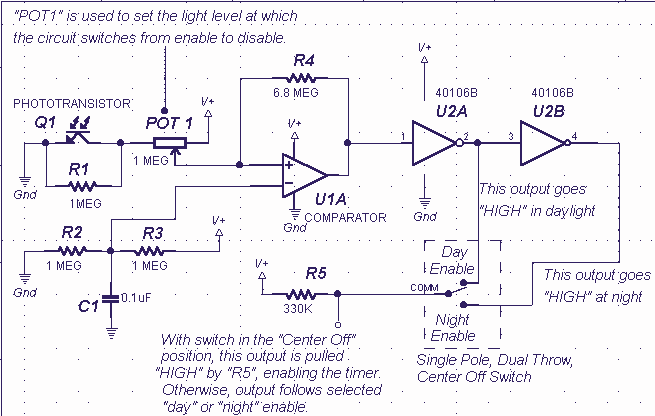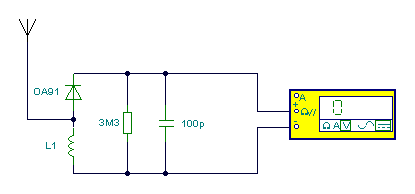
Simple Day/Night switch (40106B)

This is a simple circuit that does the day/night switchings you have in mind. POT1 is used to set the light level at which the circuit switches from enable to disable.
The described circuit functions as an automatic day/night switch, utilizing a photoresistor or light-dependent resistor (LDR) in conjunction with a potentiometer (POT1) to control the switching mechanism based on ambient light levels. The circuit typically includes a comparator, which compares the voltage across the LDR with a reference voltage set by the potentiometer.
When the ambient light level falls below the threshold set by POT1, the comparator output changes state, triggering a relay or a transistor to switch on connected loads, such as outdoor lights or other devices. Conversely, as the light level rises above the threshold, the output state changes again, turning off the load.
The circuit may also incorporate additional components such as capacitors for noise filtering and resistors to limit current through the LDR and ensure stable operation. The design should ensure that the LDR is shielded from direct light sources to prevent false triggering during transient conditions.
For practical implementation, it is essential to choose the appropriate values for the resistors and the potentiometer to achieve the desired sensitivity and response time. Testing under various lighting conditions will help fine-tune the circuit for optimal performance. This circuit is suitable for applications in outdoor lighting systems, garden lights, or any scenario where automatic control based on light levels is beneficial.This is a simple circuit that does the day/night switchings you have in mind. POT1 is used to set the light level at which the circuit switches from enable to disable. 🔗 External reference
The described circuit functions as an automatic day/night switch, utilizing a photoresistor or light-dependent resistor (LDR) in conjunction with a potentiometer (POT1) to control the switching mechanism based on ambient light levels. The circuit typically includes a comparator, which compares the voltage across the LDR with a reference voltage set by the potentiometer.
When the ambient light level falls below the threshold set by POT1, the comparator output changes state, triggering a relay or a transistor to switch on connected loads, such as outdoor lights or other devices. Conversely, as the light level rises above the threshold, the output state changes again, turning off the load.
The circuit may also incorporate additional components such as capacitors for noise filtering and resistors to limit current through the LDR and ensure stable operation. The design should ensure that the LDR is shielded from direct light sources to prevent false triggering during transient conditions.
For practical implementation, it is essential to choose the appropriate values for the resistors and the potentiometer to achieve the desired sensitivity and response time. Testing under various lighting conditions will help fine-tune the circuit for optimal performance. This circuit is suitable for applications in outdoor lighting systems, garden lights, or any scenario where automatic control based on light levels is beneficial.This is a simple circuit that does the day/night switchings you have in mind. POT1 is used to set the light level at which the circuit switches from enable to disable. 🔗 External reference





